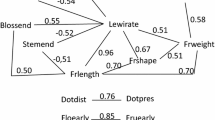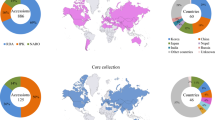Summary
Germplasm evaluation data on more than 800 accessions of red clover (Trifolium pratense L.) representing 41 countries of origin were examined from the Germplasm Resource and Information Network of the National Plant Germplasm System. Large variations exist for most characters over all origins. Clustering accessions using standardized values of 15 morphological and physiological descriptors produced three distinct groups that correspond to early, medium, and late maturity groups. Within each maturity group, different similarity groups were produced. The analysis revealed a large range of diversity among the red clover accessions over all origins with the most diversity occurring in accessions from Eastern and Northern Europe. Accessions with similar attributes often were from countries with contrasting agroecological conditions. Categorizing red clover accessions into similarity groups provided a structure for sampling a limited number of entries to represent the diversity of the germplasm into a core collection. The utilization of this core collection should facilitate genetic resource management and identification of genotypes for breeding and other agronomic uses.
Similar content being viewed by others
References
Astley, D., 1987. Genetic resource conservation. Expl. Agric. 23:245–257.
Brown, A. H. D., 1989. Core collections: a practical approach to genetic resources management. Genome 31:818–824.
Brush, S. B., 1989. Rethinking crop genetic resource conservation. Conservation Biology 3:19–29.
Frankel, O. H., 1984. Genetic perspectives of germplasm conservation. pp. 161–170. In: W. K. Arber, K. Llimense, W. J. Peacock & P. Startinger, (Eds.). Genetic manipulation: Impact on man and society. Cambridge University Press, Cambridge.
Holden, J. H. W., 1984. The second ten years. p. 276–285 In: J. H. W. Holden & J. T. Williams (Eds.). Crop genetic resources: Conservation and evaluation. Allen and Unwin, Inc. Winchester, MA.
Kouamé, C. N. & K. H. Quesenberry, 1992. Relationships among accessions of red clover in the US collection. pp. 54–55. In: D. S. Wofford & K. H. Quesenberry (Eds.). Proceed. 12th Trifolium Conference. University of Florida, Gainesville, FL.
AS Institute, 1985. SAS User's Guide: Statistics. NC State Univ. Press. Cary, NC.
Souza, E. & M. E. Sorrells. 1991. Relationships among 70 North American oat germplasms: I. Cluster Analysis using the quantitative characters. Crop Sci. 31:599–605.
Smith, R. R., N. L. Taylor & S. R. Bowley, 1985. Red clover. In: N. L. Taylor (Ed.). Clover Science and Technology. Agronomy 25:457–470.
Zohary, M. & D. Heller, 1984. The Genus Trifolium. Israeli Academy of Sciences and Technology, Jerusalem.
Author information
Authors and Affiliations
Rights and permissions
About this article
Cite this article
Kouamé, C.N., Quesenberry, K.H. Cluster analysis of a world collection of red clover germplasm. Genet Resour Crop Evol 40, 39–47 (1993). https://doi.org/10.1007/BF00053463
Received:
Accepted:
Issue Date:
DOI: https://doi.org/10.1007/BF00053463




